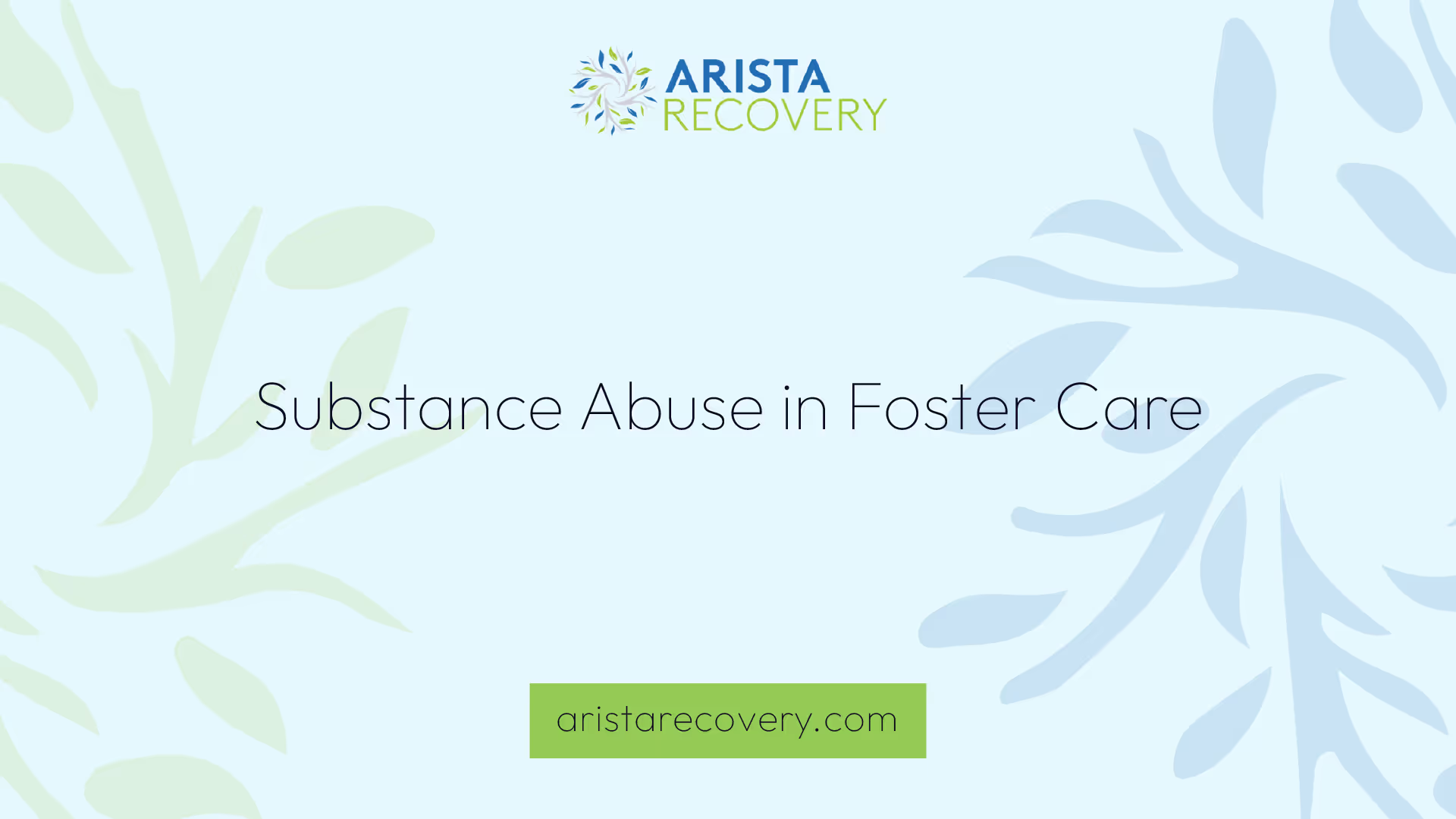Substance Abuse in Foster Care

Substance Abuse in Foster Care
Substance abuse in foster care is a pervasive issue that has significant implications for the health and wellbeing of these vulnerable individuals. This article focuses on the rates of substance use disorders and the risk factors associated with substance use in this population.

Rates of Substance Use Disorders
In comparison to the general population, rates of substance use in foster youth transitioning to adulthood may be lower. However, rates of diagnosable substance use disorders are consistently higher among youth in foster care [1].
Research indicates that 45% of foster care youth reported using alcohol or illicit drugs within the last six months, 49% had tried drugs sometime during their lifetime, and 35% met criteria for a substance use disorder.
These figures bring to light the substantial prevalence of substance use disorders among foster care youth, underscoring the need for effective interventions and support systems.
Risk Factors for Substance Use
Several risk factors may predispose youth in foster care to substance use and substance use disorders. These include male gender, history of abuse, presence of internalizing or externalizing disorders, peer or sibling substance use, and older age at entry into child welfare.
Moreover, certain diagnoses like Conduct Disorder, or living in an independent living situation, significantly increase the likelihood of current and lifetime substance use and disorder. A diagnosis of Post Traumatic Stress Disorder also predicts an increased likelihood of polysubstance use and substance abuse disorder.
Understanding these risk factors is crucial for designing effective prevention and intervention strategies. By addressing these factors proactively, it might be possible to reduce the prevalence of substance use disorders among youth in foster care, thereby improving their overall health and life trajectories.
Substance Use Among Youth in Foster Care
Understanding the patterns of substance use among youth in foster care is essential to devise effective strategies for prevention and intervention. This section focuses on the comparison of substance use among foster care youth with the general population, and the impact of various living situations on substance use.
Comparison to General Population
Contrary to general assumptions, rates of substance use in foster youth transitioning to adulthood may be lower than the general population. However, rates of diagnosable substance use disorders among youth in foster care are consistently higher than in the general population.
In the general population, substance use increases through late adolescence and peaks in young adulthood. Youth transitioning out of the foster care system may be particularly vulnerable to substance use problems during this period.
Impact of Living Situations
Various factors associated with living situations can influence the risk of substance use and substance use disorders among youth in foster care. Key risk factors include male gender, history of abuse, presence of internalizing or externalizing disorders, peer or sibling substance use, and older age at entry into child welfare.
These findings highlight the complex interplay between individual, familial, and environmental factors in shaping the risk of substance use among youth in foster care. Understanding these dynamics is critical in developing targeted interventions to address substance abuse in foster care.
Challenges Faced by Foster Care Youth
The pathway to substance abuse in foster care is often paved by a multitude of challenges encountered by the youth in this system. These difficulties, unique to their circumstances, can greatly heighten their vulnerability to substance use and its associated risks.
Unstable Environments
One of the critical factors contributing to the increased risk of substance use among youth in foster care is the instability of their living environment. Frequent changes in foster homes, schools, and communities can lead to feelings of insecurity, stress, and anxiety. This instability can disrupt their education, limit their ability to form meaningful relationships, and hinder their emotional development.
Moreover, these young individuals may find themselves placed in unsafe environments, where they might be exposed to substance use and other risky behaviors. In such circumstances, substance use can become a coping mechanism, enabling them to deal with feelings of fear, loneliness, and hopelessness.
Lack of Stable Support Systems
Another significant challenge faced by foster care youth is the absence of a stable support system. The lack of consistent and positive guidance from caregivers, teachers, or mentors can leave them feeling lost and unsupported. This lack of support can further exacerbate feelings of isolation and loneliness, making them more susceptible to substance use as a form of self-medication or escape.
Furthermore, difficulties in finding stable housing, securing employment, accessing healthcare, and establishing meaningful relationships post-foster care can increase the risk of substance use disorders. These challenges can contribute to feelings of insecurity and uncertainty, which can, in turn, lead to substance use as a coping mechanism.
The mental health of foster care youth is another crucial factor to consider. Substance use is often a coping skill for poor mental health among students. The correlation between mental health and substance use highlights the importance of addressing the co-occurring causes linked to substance use [5].
Overall, addressing the challenges faced by foster care youth requires a comprehensive approach that not only focuses on reducing substance use but also on improving their living conditions, enhancing their support systems, and promoting their mental health.
Substance Use Disorders in Foster Care Alumni
The issue of substance abuse in foster care is not confined to the period while individuals are within the system. Alumni of foster care, especially those who have aged out or been discharged from the system, are confronted with unique struggles, often resulting in higher rates of substance use disorders (SUDs) compared to their peers.
Higher Levels Compared to Peers
Research shows that rates of SUDs are higher among foster care alumni as compared to their counterparts in the general population. The Midwest Study, the largest longitudinal examination of foster youth, indicates that lifetime rates for all four substance use diagnoses were significantly higher among young adults who had aged out or been discharged from the system. The differences were predominantly due to recent (i.e., post-exit) elevations in alcohol and drug use, rather than pre-existing conditions that may have spurred their exit from the system.
Former foster youth may engage in substance use earlier and have a faster progression to 'harder' drugs compared to their peers. This rapid escalation can exacerbate the health and social consequences associated with drug use.
According to Arms Acres, foster care alumni have significantly higher rates of alcohol and substance use disorders compared to their peers in normative populations.
Challenges After Leaving Foster Care
Exiting the foster care system presents a range of challenges for youth, which can contribute to increased substance use rates. These difficulties include finding stable housing, securing employment, accessing healthcare, and establishing meaningful relationships. The stress and uncertainty associated with these challenges can often lead to substance use as a coping mechanism.
The severity of these challenges underscores the need for robust post-care support systems for foster care alumni. This includes counseling services, education, and training programs, and resources to help them transition into independent living and adulthood.
The issue of substance abuse among foster care alumni is a complex one, requiring comprehensive solutions. It's crucial to remember that these individuals often come from difficult backgrounds and face unique challenges. Society, as a whole, has a responsibility to provide the necessary support and resources to help foster care alumni overcome these obstacles and lead healthy, productive lives.
Parental Substance Abuse in Child Welfare
Substance abuse within families, particularly involving parents, can significantly impact children's welfare. The effects are far-reaching, impacting children's well-being and the overall family dynamics.
Impact on Children
Parental substance abuse is associated with an increased risk of child abuse and neglect, with one-third to two-thirds of child maltreatment cases involving some degree of substance use. Children who experience abuse or neglect are at higher risk for internalizing and externalizing disorders, such as anxiety, depression, conduct problems, and substance abuse.
In addition, children living in homes where there is an addiction may have to take on adult roles and care for themselves and younger siblings at a very young age. This phenomenon, known as "parentified children", can lead to difficulties with setting healthy boundaries in relationships and maintaining self-awareness.
Educational problems are also associated with parental substance abuse. These include unexcused absences, truancy, learning difficulties, and behavioral problems. Chaotic home environments, witnessing domestic violence, and safety concerns contribute to these issues.
Adverse Effects on Family Dynamics
Substance use disorders (SUDs) can negatively affect emotional and behavioral patterns in families from the beginning, resulting in poor outcomes for both children and adults with SUDs. The impacts include disruption of attachment, rituals, roles, routines, communication, social life, and finances.
Furthermore, parents and family members of adults with substance use disorders often engage in enabling behaviors, which can perpetuate the addiction. This could potentially create an unhealthy cycle of dependency and abuse within the family unit. Social workers can support parents in seeking help for themselves through programs like Al-Anon and Nar-Anon.
Addressing the issue of parental substance abuse is pivotal in ensuring the welfare and stability of children, especially those in foster care. With adequate support and treatment initiatives, families can work towards overcoming these challenges and fostering healthier dynamics.
Addressing Substance Use in Foster Care
Addressing substance abuse in foster care involves two main strategies: treatment initiatives for the individuals battling substance use disorders (SUDs) and support for families affected by these conditions.
Treatment Initiatives
Effective treatment initiatives are crucial for addressing substance abuse in foster care, particularly among individuals who have aged out of the system. According to the NCBI, Family Treatment Drug Court and newly developed home-based substance abuse treatment interventions appear to be the most effective at improving substance abuse treatment initiation and completion in child welfare populations [8]. These initiatives offer a comprehensive approach to treatment, combining medical care, therapy, and other supportive services to help individuals overcome their addiction and achieve better health outcomes.
Support for Families
In addition to treatment initiatives, support for families is also a critical aspect of addressing substance abuse in foster care. Parents and family members of adults with substance use disorders often engage in enabling behaviors, which can perpetuate the addiction. Social workers can support parents in seeking help for themselves through programs like Al-Anon and Nar-Anon. These support groups provide education and coping strategies for families dealing with a loved one's addiction.
Substance use disorders (SUDs) negatively affect emotional and behavioral patterns in families from the beginning, resulting in poor outcomes for children and adults with SUDs [7]. Children living in homes where there is an addiction may develop into "parentified children" who take on adult roles and care for themselves and younger siblings at young ages. This can lead to difficulties with setting healthy boundaries in relationships and maintaining self-awareness.
Therefore, supporting families affected by substance abuse in foster care is vital. It not only helps them cope with the challenges brought about by the condition but also reduces the risk of detrimental effects such as child abuse, neglect, and the development of internalizing and externalizing disorders such as anxiety, depression, conduct problems, and substance abuse. By providing effective treatment and supportive services, it is possible to lessen the impact of substance abuse in foster care and improve outcomes for those affected.
References
[1]: https://www.ncbi.nlm.nih.gov/pmc/articles/PMC2786185/
[2]: https://www.ncbi.nlm.nih.gov/pmc/articles/PMC2633867/
[5]: https://www.nctsn.org/resources/making-connection-trauma-and-substance-abuse
[6]: https://www.ncbi.nlm.nih.gov/pmc/articles/PMC3596821/
You’re not alone in this.
When mental health challenges and addiction intersect, it can feel isolating. At Arista, we offer compassionate, evidence-based, and trauma-informed care to help you heal, grow, and move forward.
You’re not alone in this.
When mental health challenges and addiction intersect, it can feel isolating. At Arista, we offer compassionate, evidence-based, and trauma-informed care to help you heal, grow, and move forward.
Support that moves with you.
You’ve taken a brave first step. At Arista Recovery, we’re here to help you continue with best-in-class care designed for long-term healing and support.
.webp)






